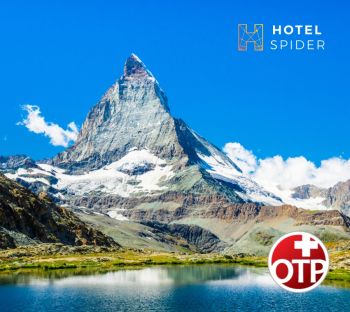
Like many hoteliers, you may use a fixed price per room - regardless of whether you have been booked to maximum occupancy or not. It's easier and makes the number of rates you need to keep track of more manageable.
The what, how, and why behind occupancy-dependent room prices
Occupancy-dependent room pricing: What they are and why they increase your revenue
Occupancy-dependent room prices also offer a lot of advantages for both guests and hotels. Examples include increased flexibility, better value for money, and higher revenue.
Plus, this price strategy is now even easier to implement. Today, it’s enough to just set the prices for different occupancy variants once in your PMS. Then Channel Manager will do the rest.
Let’s take a closer look at how it works and why it’s worth it.
What are occupancy-dependent room prices?
When you use occupancy-based prices, the rate for a room depends on how many guests will use it. This results in different prices for a room category depending on the specified occupancy.
This type of pricing can make your hotel more flexible and create more revenue potential for every room.
Advantages of occupancy-dependent room pricing
Although occupancy-dependent rates are a bit more work at first, they offer your hotel a number of benefits that more than justify the effort.
-
• Cost coverage: More guests in rooms leads to higher use of resources. This leads to higher costs for cleaning, because more towels are swapped and more toiletries need to be refilled, for example. Occupancy-dependent prices help compensate for these extra costs.
-
-
• Broader reach: When you use person-dependent pricing, your rooms can be found by more people. For example, single travelers can also see your larger categories at their adjusted prices. Plus, rates are automatically updated depending on search settings so that guests can immediately see the correct price for their booking.
-
-
• Increased revenue: According to Booking.com, occupancy-dependent prices can increase your revenue by up to 3.5%. There are a few reasons why. On the one hand, the price structure is more comprehensible for guests. And above all, price-conscious travelers often think the value for money is better here.
On the other hand, guests can compare rates more easily, and know exactly what their costs will be. This transparency makes your establishment look better during hotel searches.
-
• Optimized capacity: Because more guests have access to your bigger, more expensive rooms, it increases the likelihood that they will be booked. Smaller, cheaper rooms stay free for guests that prefer a lower category. In this way, you can optimize capacity, which also has a positive effect on your revenue.
-
-
• More flexibility: In periods of low capacity, you can also make larger rooms more attractive to single travelers and couples using occupancy-dependent pricing. During the high season, you can switch back to fixed prices that aren’t based on occupancy. But if an individual wants to book your largest suite anyway, you still benefit from the profitability of the reservation.

How to increase reservations and revenue using occupancy-dependent pricing
Person-dependent room prices can help as part of your revenue management strategy, and increase revenue and occupancy. There are two options for implementing this.
Option 1: Use the same pricing strategy throughout the entire year
In this case, you use the same strategy throughout the whole year. Regardless of how high demand is or which segments are being booked more often at a given time, you either stick with fixed prices or person-dependent rates. You save time, because you don't need to think about when to offer flexible prices and when not to.
You can enjoy the benefits of occupancy-dependent pricing all year round, for example. At the same time, you may also lose out on revenue during the high season.
Option 2: Adapt your price strategy depending on the season and market conditions
If you’re able and willing to invest a bit more time, there is the possibility of only using occupancy-dependent pricing under certain circumstances.
Let’s assume that lots of solo business travelers book with you during the week. Most of them aren't as price conscious as vacationers. So in this case it’s worth sticking with the maximum fixed price, regardless of occupancy. You achieve good revenue with relatively lower costs, since rooms aren’t fully occupied.
If more private travelers reserve with you on weekends or during holidays, person-dependent pricing may be better. This makes your rates more attractive and comprehensible for this more price-conscious audience.
This flexible pricing can also be helpful for attracting guests during less busy periods.
How to implement occupancy-dependent room pricing in four easy steps
The good news is that you don't need much to do it. Whereas before lots of manual steps were required, now you just need to make a few considerations and easy movements.
1. Establish occupancy variants:
Decide on the maximum number of guests that can spend the night in every room. This depends on the size of the room and the number of sleeping facilities available (e.g. beds, sofa beds, room for additional beds...)
2. Set prices for occupancy variants:
How much do you want to charge per additional guest? Above all, this depends on the added value the occupancy variant brings to the guest.
3. Load the new variants and prices in your system:
Save the new occupancy variants and their prices in your PMS and Channel Manager. You can quickly change values here if you follow different strategies during busy and quiet seasons. If you have any specific questions about settings in Hotel-Spider, please contact our team directly.
4. Synchronize with your OTAs:
Leading OTAs like Expedia and Booking.com support occupancy-dependent room prices. This means that the occupancy variants and prices you load in your system can be passed on and applied via the Channel Manager to the OTA 1:1. You don't need to enter individual rates manually on each channel. This saves time and helps avoid mistakes.
But be careful: Not all OTAs support occupancy settings to the same extent. Hotel-Spider’s flexible price derivation, you can display occupancy-dependent prices can on almost every portal. Reach out to our experts if you have questions about the respective settings or channels.
If you want to test out or optimize occupancy-dependent pricing in your hotel, you’ve come to the right place.
Get in contact with us so we can analyze your current situation and find the best solution for your hotel.
It’s worth it, because an optimized strategy can help you realize benefits such as broader reach and increased hotel revenue.


